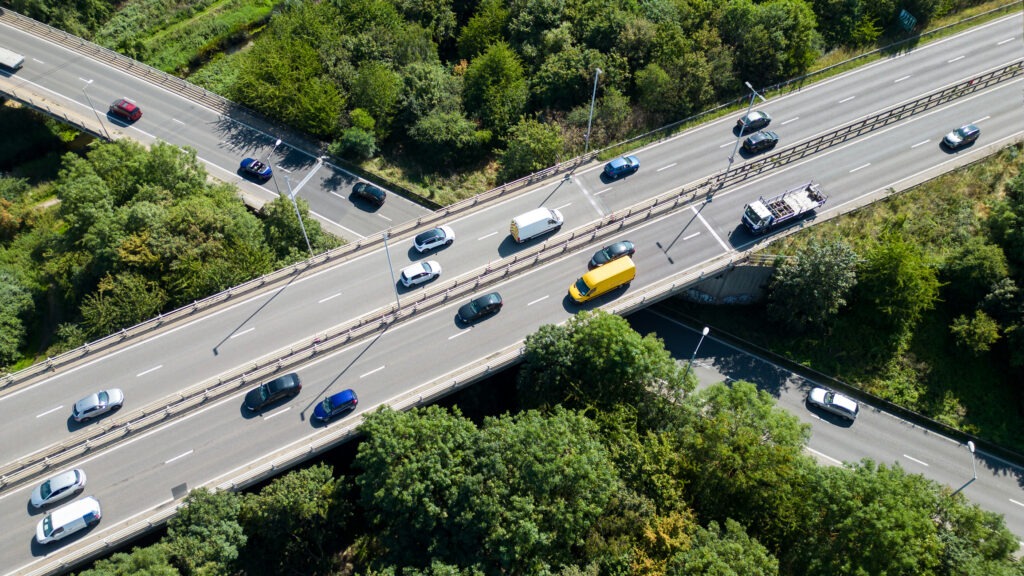EU new-car market suffers worst performance in over two years
20 September 2024

EU new-car registrations declined sharply in August, marking their biggest drop since April 2022. Battery-electric vehicles (BEVs) contributed heavily to this slump. Tom Hooker, Autovista24 journalist, reviews the results.
Recording 643,637 registrations, the EU new-car market shrank by 18.3% year on year in August. This equated to a drop of over 144,000 units. Not only was this the largest percentage decline in 29 months, but it is also the lowest August delivery total in three years.
The latest data from the European Automobile Manufacturers Association (ACEA) shows that every powertrain endured a double-digit decline in the month. The only exception to this rule was the combined category of full (HEVs) and mild hybrids (MHEVs).
Major markets struggle
Germany and France, the EU’s two largest new-car markets, saw registrations slump 27.8% and 24.3% respectively. Italy also posted a sharp decline of 13.4%, while volumes in Spain decreased 6.5%, the country’s first drop since March. Outside of the EU, the UK suffered a 1.3% fall in deliveries.
Looking at the remaining five-digit total markets, both Belgium and Sweden saw registrations decline by 20.3%. Portugal (down 9.4%), Austria (down 8.9%), Czech Republic (down 8.7%), Denmark (down 5.1%) and the Netherlands (down 0.4%) also endured decreases. Only Poland was able to post an improvement, up 2.5%.
Of the 27 EU member states, it was one of only four markets to record growth in August. Expanding this to the UK and the European Free Trade Association regions of Iceland, Norway and Switzerland, only five out of 31 countries enjoyed an increase in deliveries.
Across the first eight months of the year, the EU new-car market was up 1.4% with 7.18 million registrations. However, this was down from the 3.9% year-on-year growth recorded between January and July.
The big five markets had contrasting fortunes in this period. Germany and France were down 0.3% and 0.5% respectively. Meanwhile, Italy and Spain were up 3.8% and 4.5% respectively.
However, other six-figure markets were not so positive, namely Sweden (down 7.8%), Belgium (down 3.3%), the Netherlands (down 3.2%) and Ireland (down 0.9%). Elsewhere, Poland (up 14.8%), Romania (up 8%), Portugal (up 2.5%), the Czech Republic (up 2.3%) and Denmark (up 1.5%) saw growth.
Battered BEVs
BEVs suffered the biggest drop of any powertrain in August. The technology plummeted 43.9% year on year, with 92,627 deliveries. This equated to a drop of over 72,000 units, and a massive market share drop of 6.6 percentage points (pp) to 14.4%. The powertrain sat 3.2pp ahead of diesel, compared to 8.6pp 12 months ago.
August is the first full month after the EU brought in its provisional tariffs on Chinese-built BEVs. The duties came into effect on 5 July, with different carmakers seeing different rates based on government subsidies and cooperation with the investigation.
Excluding the technology from the overall figures gives the new-car market a smaller decline of 11.5%.
Incentive impact
The drop was partly due to a 68.8% slump in Germany. This was caused by an incentive pull-forward effect in August 2023, with BEV subsidies for businesses ending at the start of September that year.
The resulting rush meant BEV registrations topped the country’s figures for the first time ever. Therefore, the sharp fall is the result of an anomaly, rather than a serious lack of demand.
France, the next biggest market for the powertrain, dropped 33.1%. The country is in a unique position, as its incentive programme is determined by a BEV’s CO2 footprint. This affects more affordable all-electric made in China.
The only other five-digit BEV market in August, Belgium, improved volumes by 8.5%. Italy saw registrations fall by 40.9%, followed by Finland (down 32.7%), Sweden (down 30.6%), Ireland (down 29.5%), Spain (down 24.8%), Austria (down 21.4%) and Portugal (down 19%).
BEVs deliveries in Denmark grew by 47.7% and in the Netherlands the technology rose by 3%. This was not enough to reach five figures, with August again proving a slow month in the country.
Differing results
In the year to date, BEVs were the second-worst-performing powertrain, declining 8.3% with 902,011 deliveries. All-electric cars made up 12.6% of the EU’s new-car market, with a more marginal year-on-year drop of 1.3pp.
The four biggest BEV markets had differing results in this period. While Germany dropped 32%, registrations in France increased by 8.1%. Belgium surged 41.3%, while the Netherlands enjoyed a rise of 4.5%.
Looking at other noteworthy performances, Finland slumped 30.3%, followed by Ireland (down 25.4%) Sweden (down 21%), Italy (down 12.3%) and Austria (down 7.9%). Yet, BEV volumes in Denmark jumped by 50.8%, as Portugal (up 9.5%), Spain (up 2.5%) and Poland (1%) posted growth.
PHEVs in a panic?
With a sharp 22.3% decline, plug-in hybrids (PHEVs) were the third-worst performing powertrain in August. A total of 45,590 registrations were recorded, resulting in a drop of more than 13,000 units. The technology’s market share fell slightly from 7.4% in August 2023 to 7.1% last month.
The poor PHEV performance was fuelled by a 56.9% decline in Belgium and a 35.3% decrease in France, the biggest decline in terms of volume. This equated to a loss of over 8,000 units. Germany, the biggest PHEV market, also dropped 6.8%.
Other notable drops came from Finland (down 24.2%), Austria (down 23%), Italy (down 21.2%), Portugal (down 17.1%), Sweden (down 15.2%) and Spain (down 10.5%). All these double-digit declines were based on lower volumes. The only four-digit region to manage PHEV growth was the Netherlands, up 10.7%.
A smaller decline
In the first eight months of the year, PHEV deliveries were down 5% with 501,266 units. The technology took a market share of 7% from January to August, down 0.5pp year on year.
Out of the seven biggest EU plug-in hybrid markets, Germany, Sweden and the Netherlands achieved year-to-date PHEV growth of 9.2%, 3.8% and 3.2% respectively. Meanwhile, Belgium slumped 21.3%, followed by France (down 11.6%), Italy (down 11.5%) and Spain (down 5%).
Elsewhere, Finland and Austria declined by 17.4% and 3% respectively. On the other hand, PHEV deliveries increase in Ireland by 19.3% and by 8.8% in Portugal.
Combining BEV and PHEV volumes, the electric vehicle (EV) market fell 38.3% in August with 138,217 registrations. This was a drop of more than 85,000 units compared to 12 months ago. The plug-in market share slumped 6.9pp in the month, ending at 21.5%.
From January to August, a total of 1.4 million EVs took to European roads, declining 7.2% year on year. This was a big drop from a 1.2% decrease in the first seven months of the year. Plug-ins accounted for 19.5% of the new-car market in the year to date, down from 21.4% during the same period one year ago.
CO2 target concerns
This worrying BEV performance could concern European manufacturers, who are preparing for the new CO₂ emissions target for passenger cars. This comes into effect from next year until 2029, when the EU-wide fleet target is 93.6g/km instead of 95g CO2/km, which has been applied since 2020.
ACEA has voiced fears about meeting these targets. ‘The zero-emission transition is highly challenging, with concerns about meeting the 2025 CO2 emission reduction targets for cars and vans on the rise,’ the association said.
‘The current rules do not account for the profound shift in the geopolitical and economic climate over the past years and the law’s inherent inability to adjust for real-world developments further erodes the competitiveness of the sector,’ it said.
‘This raises the daunting prospect of either multi-billion-euro fines, which could otherwise be invested in the zero-emission transition, or unnecessary production cuts, job losses, and a weakened European supply and value chain at a time when we face fierce competition from other automaking regions.
‘The industry cannot afford to wait for the review of the CO₂ regulations in 2026 and 2027, we need urgent and meaningful action now to reverse the downward trend, restore EU industry competitiveness and reduce strategic vulnerabilities,’ the board stated.
Damaging diesel performance
Diesel was the second worst-performing powertrain in the month, declining 26.4% with 72,177 deliveries. This equated to a drop of almost 26,000 units. Its market share fell 1.2pp to 11.2% in August.
Germany had the biggest volume decrease in the month, with a 24.4% decline. Italy, diesel’s second-largest market, plummeted 29%.
Other four-digit countries posting declines were Belgium (down 47.4%), France (down 42.6%), Austria (down 36.5%), Spain (down 27.2%), Sweden (down 12.9%) Ireland (down 10.7%) and the Netherlands (down 4.7%). The Czech Republic was the only region in this size bracket to record growth, up 2.6%.
In the first eight months of the year, diesel registrations dropped 9.7%, with 909,592 units. The powertrain’s market share suffered a sharper share drop in the year to date, falling from 14.2% to 12.7%.
The biggest diesel market, Germany, was up 4% from January to August. However, the next three largest diesel regions of Italy, France and Spain, were down 21.5%, 24.8% and 18.1% respectively.
Other five-digit markets that struggled were Belgium (down 46.8%), Portugal (down 27.5%), Sweden (down 16.8%) Slovakia (down 5.6%) Austria (down 2.3%) and the Czech Republic (down 1.4%). However, Romania improved diesel deliveries by 29.4%, as Poland and Ireland were both up 1.8%.
Puzzling Petrol
Petrol did not fare much better than its internal combustion engine (ICE) counterpart in August. Volumes dropped 17.1% in the month to 213,057 registrations. This was a loss of over 44,000 units year on year. However, due to other powertrains suffering stronger declines, its market share rose 0.5pp to 33.1%.
The six largest petrol markets endured falls in August, starting with a 7.4% decrease in Germany. Then came France (down 36.6%), Italy (down 18.8%), Spain (down 17.4%), Poland (down 2.5%) and Belgium (down 15.5%).
In the year to date, petrol has posted 2.5 million deliveries, a decrease of 2.9%. Yet, despite a more marginal decline in this period compared to August alone, its market share dropped 1.6pp to 34.9%.
Italy and Germany have enjoyed petrol growth so far in 2024, with registrations up 10.4% and 4.9% respectively. Meanwhile, registrations fell by 16.5% in France, followed by Belgium (down 7%), Poland (down 2.5%) and Spain (down 3.5%).
Combining diesel and petrol volumes, the ICE market dropped 19.7% in August, with 285,234 deliveries. It accounted for 44.3% of the new-car market in the month, down from the 45.1% recorded one year ago.
From January to August, the ICE market reached over 3.4 million registrations, declining 4.8%. It captured 47.5% of the market in this period, down 3.2pp.
Hybrid heaven
The hybrid category prevented an even steeper new-car market decline in August. The technology grew 6.6% in the month, recording 201,552 deliveries. Excluding hybrids from the overall figure, the market would have declined by 26.2%.
The powertrain’s market share surged in August, up 7.3pp to 31.3%. It sat just 1.8pp behind the market leader petrol, compared to an 8.6pp gap 12 months ago. Adding hybrids to the EV total, electrified powertrains accounted for 52.8% of new-car registrations, up from 52.4% in August 2023.
Germany's hybrid market remained stable in the month, dropping 0.1% year on year. However, double-digit growth was enjoyed in Spain (up 12.6%) and France (up 12.5%). Further increases were seen in Poland (up 8.8%) and Italy (up 2.5%).
Double-digit growth
In the year to date, hybrids surged 21.1% to over 2.1 million deliveries. The technology made up 29.8% of new-car volumes in the first eight months of the year, rising from the 24.9% share recorded one year ago. Electrified powertrains took a 49.3% market hold in this period, an improvement of 3pp year on year.
Every five-digit market has seen double-digit hybrid growth so far in 2024. The highest rate was achieved in Poland, with registrations increasing by 39.5%, followed by France (up 35.6%), Spain (up 25.3%), Italy (up 14.8%) and Germany (up 11.9%).
The ‘others’ category, including hydrogen fuel-cell electric vehicles, natural gas and liquified petroleum gas vehicles, E85/ethanol, and other fuels, saw volumes fall 5.3% last month. With 18,634 deliveries, the grouping took a 2.9% market share, up from 2.5% in August 2023.
Across the first eight months of the year, the category reached similar growth, with 224,692 registrations resulting in a 5.2% increase. The powertrain improved its share by 0.1pp to 3.1% in this period.




